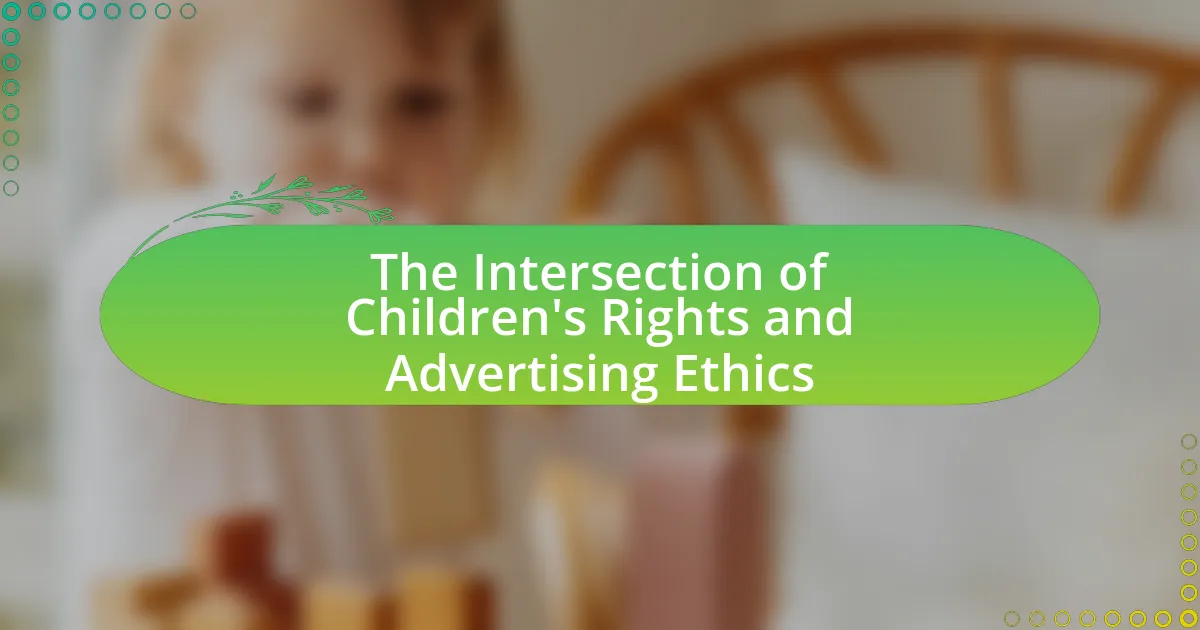The article examines international perspectives on children’s advertising regulations, highlighting the significant variations across countries influenced by cultural values and societal concerns. It discusses the strict bans in countries like Sweden and Norway aimed at protecting children under 12 from commercial exploitation, contrasting with the more lenient self-regulatory approach in the United States. The article emphasizes the importance of these regulations in safeguarding children’s well-being, reducing childhood obesity, and mitigating negative behavioral outcomes linked to advertising. Additionally, it explores the challenges faced by countries in enforcing these regulations, particularly in the context of technological advancements and the influence of multinational corporations.
What are International Perspectives on Children’s Advertising Regulations?
International perspectives on children’s advertising regulations vary significantly across countries, reflecting cultural values and societal concerns. For instance, in Sweden and Norway, there are strict bans on advertising to children under 12 years old, aimed at protecting young audiences from commercial exploitation. In contrast, the United States employs a more lenient approach, relying on self-regulation by the advertising industry, although the Federal Trade Commission monitors practices to ensure they are not deceptive. Research by the World Health Organization highlights that countries with stringent regulations report lower rates of childhood obesity, suggesting a correlation between advertising restrictions and healthier outcomes for children.
Why are children’s advertising regulations important globally?
Children’s advertising regulations are important globally because they protect young audiences from misleading and harmful marketing practices. These regulations ensure that advertisements do not exploit children’s vulnerability, as research indicates that children are less able to critically evaluate advertising messages compared to adults. For instance, the World Health Organization highlights that unregulated advertising can contribute to unhealthy dietary habits and obesity among children, emphasizing the need for protective measures. By establishing guidelines that limit the types of products marketed to children and the methods used, countries can promote healthier lifestyles and safeguard children’s well-being on a global scale.
What are the potential impacts of advertising on children’s behavior?
Advertising significantly influences children’s behavior by shaping their preferences, consumption habits, and social interactions. Research indicates that children exposed to advertising are more likely to develop brand loyalty and request advertised products, which can lead to increased materialism and unhealthy eating habits. For instance, a study published in the journal “Pediatrics” found that children who viewed food advertisements were more likely to choose unhealthy snacks over healthier options, demonstrating a direct correlation between advertising exposure and dietary choices. Additionally, advertising can affect children’s social behaviors, as they may mimic behaviors seen in commercials, such as aggressive or competitive actions. This influence underscores the importance of regulating advertising targeted at children to mitigate negative behavioral outcomes.
How do cultural differences influence children’s advertising regulations?
Cultural differences significantly influence children’s advertising regulations by shaping the values and norms that govern how children are marketed to in various societies. For instance, in countries like Sweden and Norway, strict regulations prohibit advertising directed at children under the age of 12, reflecting a cultural emphasis on protecting children’s innocence and promoting ethical marketing practices. Conversely, in the United States, advertising to children is more prevalent, driven by a consumer culture that prioritizes economic growth and brand loyalty, resulting in less stringent regulations. This disparity illustrates how cultural attitudes towards childhood, consumerism, and ethical standards directly impact the formulation and enforcement of advertising regulations for children across different nations.
What are the key components of children’s advertising regulations?
The key components of children’s advertising regulations include restrictions on misleading content, limitations on the use of certain persuasive techniques, and guidelines for the protection of children’s privacy. These regulations aim to ensure that advertisements are truthful and not exploitative, particularly regarding children’s vulnerability to manipulation. For instance, many countries enforce rules that prohibit advertisements from depicting unhealthy food as desirable, reflecting a growing concern about childhood obesity. Additionally, regulations often require clear labeling of advertisements to distinguish them from regular content, thereby enhancing transparency. These components are supported by various international frameworks, such as the United Nations Convention on the Rights of the Child, which emphasizes the need to protect children from harmful marketing practices.
What types of content are restricted in children’s advertising?
Content that is restricted in children’s advertising includes misleading claims, advertisements promoting unhealthy food and beverages, and content that exploits children’s inexperience or credulity. Regulations often prohibit the use of violence, sexual content, and any material that could cause physical or emotional harm. For instance, the American Psychological Association highlights that advertisements targeting children must not contain deceptive practices or exploit their lack of experience, ensuring that the content is appropriate and safe for young audiences.
How do age restrictions vary across different countries?
Age restrictions for children’s advertising vary significantly across countries, reflecting diverse cultural values and legal frameworks. For instance, in Sweden, advertising aimed at children under 12 is prohibited, while in the United States, the Federal Trade Commission allows advertising to children but mandates that it must not be deceptive or unfair. In contrast, the United Kingdom has specific guidelines that restrict advertising to children under 16 during children’s programming. These differences illustrate how countries prioritize child protection in advertising, influenced by local societal norms and regulatory approaches.
What challenges do countries face in regulating children’s advertising?
Countries face significant challenges in regulating children’s advertising due to varying cultural norms, legal frameworks, and the rapid evolution of digital media. Cultural differences influence perceptions of what constitutes appropriate advertising for children, leading to inconsistent regulations across nations. Additionally, the legal frameworks in place may lack the specificity needed to address modern advertising techniques, particularly in digital spaces where children are increasingly targeted. For instance, the rise of social media influencers and targeted online ads complicates enforcement, as traditional regulations may not apply effectively. Furthermore, the global nature of advertising means that companies can easily circumvent local laws by operating from jurisdictions with looser regulations, making it difficult for individual countries to protect children effectively.
How do technological advancements complicate advertising regulations?
Technological advancements complicate advertising regulations by enabling more targeted and personalized advertising, which can lead to ethical concerns regarding children’s exposure to inappropriate content. The rise of digital platforms and data analytics allows advertisers to collect detailed information about users, including children, and tailor ads based on their online behavior. This capability raises challenges for regulators who must ensure that advertising practices protect vulnerable populations, particularly minors, from manipulative marketing tactics. For instance, the use of algorithms to target children with specific ads can circumvent traditional regulatory frameworks that were designed for broader, less personalized advertising methods.
What role do multinational corporations play in these challenges?
Multinational corporations significantly influence challenges related to children’s advertising regulations by shaping marketing practices and standards across different countries. These corporations often leverage their global reach to promote products to children, which can lead to regulatory discrepancies as they navigate varying legal frameworks. For instance, companies like McDonald’s and Coca-Cola have faced scrutiny for their advertising strategies aimed at children, prompting discussions on the need for stricter regulations to protect young audiences. Research indicates that aggressive marketing tactics employed by these corporations can contribute to unhealthy dietary habits among children, highlighting the necessity for cohesive international regulations to mitigate such impacts.
How do different countries approach children’s advertising regulations?
Different countries approach children’s advertising regulations through varying degrees of restrictions and guidelines aimed at protecting minors from misleading marketing practices. For instance, Sweden and Norway have strict bans on all forms of advertising directed at children under the age of 12, emphasizing the protection of children from commercial exploitation. In contrast, the United States employs a more lenient framework, where the Federal Trade Commission (FTC) provides guidelines but does not impose outright bans, allowing for significant advertising directed at children. The European Union has established directives that require member states to implement regulations that limit advertising to children, focusing on issues like misleading claims and the promotion of unhealthy food products. These diverse approaches reflect cultural attitudes towards child welfare and consumer protection, with some countries prioritizing strict regulations to safeguard children, while others adopt a more permissive stance that encourages parental responsibility and market freedom.
What are the regulatory frameworks in the United States?
The regulatory frameworks in the United States encompass a variety of laws and guidelines that govern advertising practices, particularly those aimed at children. Key regulations include the Children’s Online Privacy Protection Act (COPPA), which mandates parental consent for the collection of personal information from children under 13, and the Federal Trade Commission Act, which prohibits unfair or deceptive acts in advertising. Additionally, the Children’s Advertising Review Unit (CARU) provides self-regulatory guidelines that focus on responsible advertising to children, ensuring that advertisements are not misleading and promote positive values. These frameworks collectively aim to protect children from exploitation in advertising and ensure ethical marketing practices.
What specific laws govern children’s advertising in the U.S.?
The primary laws governing children’s advertising in the U.S. include the Children’s Television Act of 1990 and the Federal Trade Commission Act. The Children’s Television Act mandates limits on advertising during children’s programming and requires that a certain amount of educational content be included. The Federal Trade Commission Act prohibits deceptive advertising practices, which applies to advertisements targeting children, ensuring that they are not misleading. These laws are enforced by the Federal Communications Commission and the Federal Trade Commission, respectively, to protect children from exploitative marketing practices.
How effective are these regulations in protecting children?
The effectiveness of regulations in protecting children is significant, as they are designed to limit exposure to harmful advertising practices. Studies indicate that countries with stringent advertising regulations, such as Sweden and Norway, report lower rates of childhood obesity and improved mental health outcomes among children. For instance, the World Health Organization has noted that comprehensive advertising restrictions can lead to a 20% reduction in unhealthy food consumption among children. These regulations help create a safer environment for children by minimizing their exposure to manipulative marketing tactics that exploit their vulnerabilities.
What are the regulations in European countries?
European countries have established various regulations governing children’s advertising to protect minors from misleading or harmful content. The Audiovisual Media Services Directive (AVMSD) is a key framework that sets standards across the European Union, prohibiting advertisements that exploit children’s inexperience or fear. Additionally, many countries have specific national laws, such as the UK’s CAP Code, which restricts the types of products that can be advertised to children and mandates that advertisements must not mislead or cause harm. These regulations are supported by research indicating that children are particularly vulnerable to advertising tactics, necessitating stringent protections to ensure their well-being.
How do the EU’s directives shape children’s advertising practices?
The EU’s directives shape children’s advertising practices by establishing strict regulations that limit the types of advertisements directed at children and the content of those advertisements. For instance, the Audiovisual Media Services Directive (AVMSD) prohibits advertisements for unhealthy food and beverages during children’s programming, aiming to protect young audiences from misleading marketing tactics. Additionally, the General Data Protection Regulation (GDPR) imposes stringent requirements on the collection and use of children’s personal data in advertising, ensuring that children’s privacy is prioritized. These directives collectively create a framework that promotes responsible advertising practices and safeguards children’s well-being across EU member states.
What differences exist between member states in enforcement?
Member states exhibit significant differences in enforcement of children’s advertising regulations, primarily due to variations in legal frameworks, cultural attitudes, and regulatory bodies. For instance, countries like Sweden and Norway enforce strict bans on advertising directed at children under 12, reflecting a strong cultural emphasis on child protection. In contrast, the United States employs a more lenient approach, allowing advertising with fewer restrictions, which is influenced by market-driven principles. Additionally, the European Union provides a general framework, but individual member states have the discretion to implement and enforce regulations differently, leading to inconsistencies in how laws are applied. This divergence is evident in the varying levels of penalties for non-compliance, with some countries imposing hefty fines while others rely on voluntary compliance measures.
How do Asian countries regulate children’s advertising?
Asian countries regulate children’s advertising through a combination of legal frameworks, industry guidelines, and self-regulatory measures. For instance, South Korea enforces strict regulations under the Act on the Protection of Children and Youth from Sexual Abuse, which limits advertising aimed at children and mandates clear labeling of promotional content. In Japan, the Broadcasting Ethics and Program Improvement Organization provides guidelines that restrict misleading advertisements directed at children, emphasizing the need for honesty and clarity. Additionally, countries like China have implemented the Advertising Law, which prohibits false advertising and requires that advertisements for children’s products be in the best interest of children’s health and development. These regulations are designed to protect children from exploitation and ensure that advertising practices are ethical and responsible.
What unique challenges do Asian countries face in this area?
Asian countries face unique challenges in children’s advertising regulations due to cultural diversity, varying economic conditions, and differing levels of regulatory enforcement. For instance, the presence of multiple languages and cultural norms complicates the establishment of a unified regulatory framework, as seen in countries like India and Indonesia, where regional variations significantly influence advertising practices. Additionally, the rapid growth of digital media in Asia, particularly in countries like China and the Philippines, poses challenges in monitoring and regulating online advertisements targeted at children. According to a report by the World Health Organization, the lack of comprehensive regulations in many Asian nations leads to increased exposure of children to unhealthy food advertising, which can contribute to rising obesity rates. These factors collectively hinder the effectiveness of children’s advertising regulations across the region.
How do cultural values influence advertising regulations in Asia?
Cultural values significantly influence advertising regulations in Asia by shaping the ethical standards and content appropriateness deemed acceptable in marketing. For instance, collectivist cultures, prevalent in many Asian countries, prioritize community and family, leading to regulations that restrict advertisements promoting individualism or materialism, which may be seen as detrimental to social harmony. Additionally, cultural norms regarding modesty and respect can result in stricter guidelines on sexual content and portrayals of gender roles in advertisements. Countries like Japan and South Korea have specific regulations that reflect these cultural sensitivities, ensuring that advertising aligns with societal values and expectations. This alignment is crucial for maintaining public trust and preventing backlash against brands that may violate these cultural norms.
What are the implications of children’s advertising regulations on society?
Children’s advertising regulations significantly impact society by promoting healthier consumption habits and reducing the exploitation of vulnerable audiences. These regulations aim to limit misleading advertisements targeting children, which can lead to unhealthy lifestyle choices, such as poor dietary habits and increased consumerism. For instance, studies have shown that countries with strict advertising regulations, like Sweden and Norway, report lower rates of childhood obesity compared to those with lax regulations. Furthermore, these regulations foster a more ethical advertising environment, encouraging brands to create responsible marketing strategies that prioritize children’s well-being over profit. This shift not only benefits children’s health but also cultivates a more informed and critical consumer base in society.
How do these regulations affect children’s health and well-being?
Regulations on children’s advertising significantly improve children’s health and well-being by limiting exposure to unhealthy food marketing. These regulations often restrict advertisements for high-sugar, high-fat, and high-sodium products during children’s programming, which has been shown to reduce the consumption of unhealthy foods among children. For instance, studies indicate that countries with strict advertising regulations, such as Sweden and Norway, report lower rates of childhood obesity compared to those with less stringent rules. This correlation suggests that effective regulations can lead to healthier dietary choices and improved overall health outcomes for children.
What evidence supports the link between advertising and childhood obesity?
Research indicates a strong link between advertising and childhood obesity, primarily through the promotion of unhealthy food products to children. A systematic review published in the journal “Obesity Reviews” found that children exposed to food advertising are more likely to choose, consume, and request those advertised products, leading to increased caloric intake. Additionally, a study by the American Psychological Association revealed that children aged 2 to 11 are exposed to an average of 12 food advertisements per day, with a significant proportion promoting high-calorie, low-nutrient foods. This exposure correlates with higher rates of obesity in children, as evidenced by data from the Centers for Disease Control and Prevention, which shows a rise in childhood obesity rates alongside increased food marketing.
How do regulations impact children’s mental health?
Regulations significantly impact children’s mental health by shaping the environment in which they are exposed to advertising and media. For instance, strict advertising regulations can reduce children’s exposure to unhealthy food marketing, which has been linked to obesity and related mental health issues. Research published in the journal “Pediatrics” indicates that children who are less exposed to aggressive marketing of unhealthy products exhibit better dietary habits and improved self-esteem. Furthermore, regulations that limit the portrayal of unrealistic body images in media can help mitigate issues such as anxiety and depression among children, as evidenced by studies showing a correlation between media exposure and body dissatisfaction. Thus, effective regulations play a crucial role in promoting healthier mental health outcomes for children.
What role do advocacy groups play in shaping regulations?
Advocacy groups play a crucial role in shaping regulations by influencing policymakers and raising public awareness about specific issues. These organizations often conduct research, mobilize community support, and engage in lobbying efforts to promote regulatory changes that align with their objectives. For instance, advocacy groups focused on children’s advertising have successfully campaigned for stricter regulations to protect children from misleading marketing practices, leading to legislative changes in various countries. Their efforts are supported by studies showing that targeted advertising can negatively impact children’s health and well-being, thereby reinforcing the need for regulatory intervention.
How do these groups influence public policy on children’s advertising?
Advocacy groups influence public policy on children’s advertising by lobbying for stricter regulations and raising public awareness about the potential harms of such advertising. These organizations, such as the Campaign for a Commercial-Free Childhood, provide research and data demonstrating the negative impacts of advertising on children’s health and development, which policymakers consider when drafting legislation. For instance, in 2010, the Federal Trade Commission reported that children are particularly susceptible to advertising, leading to calls for enhanced guidelines to protect them. This evidence-based approach helps shape policies that limit the types of advertisements children can be exposed to, ultimately aiming to create a safer advertising environment for young audiences.
What strategies do advocacy groups use to raise awareness?
Advocacy groups use various strategies to raise awareness, including social media campaigns, public demonstrations, and partnerships with influential organizations. Social media campaigns leverage platforms like Twitter and Facebook to disseminate information rapidly, engaging a wide audience and encouraging sharing. Public demonstrations, such as rallies or marches, visually represent the cause, drawing media attention and public interest. Partnerships with influential organizations amplify the message, as these collaborations can reach broader demographics and lend credibility to the advocacy efforts. For instance, the American Academy of Pediatrics has collaborated with advocacy groups to address children’s advertising regulations, highlighting the importance of protecting children from misleading marketing practices.
What best practices can be adopted for effective children’s advertising regulations?
Effective children’s advertising regulations can be achieved by implementing clear guidelines that prioritize child welfare and limit exploitative practices. These guidelines should include age-appropriate content restrictions, transparency in advertising, and the prohibition of misleading claims. For instance, the American Psychological Association emphasizes that advertisements targeting children should not exploit their inexperience or credulity. Additionally, regulations should mandate that advertisements clearly distinguish between entertainment and marketing, as seen in the European Union’s Audiovisual Media Services Directive, which requires clear labeling of commercial content. Furthermore, involving parents and educators in the regulatory process can enhance the effectiveness of these regulations by ensuring that they reflect the values and concerns of the community.
How can countries collaborate to improve regulations globally?
Countries can collaborate to improve regulations globally by establishing international frameworks and agreements that standardize regulatory practices. For instance, organizations like the United Nations and the World Health Organization facilitate discussions among member states to align their regulations on children’s advertising, ensuring that all countries adhere to similar ethical standards. Evidence of successful collaboration can be seen in the adoption of the Convention on the Rights of the Child, which has influenced national laws regarding advertising to children, promoting a unified approach to protect children’s interests across borders.
What are the key elements of successful advertising regulations for children?
Successful advertising regulations for children include clear age-appropriate content guidelines, restrictions on misleading claims, and limitations on the use of persuasive techniques. These elements ensure that advertisements do not exploit children’s vulnerability and promote healthy consumption habits. For instance, regulations in countries like Sweden and Norway prohibit all advertising directed at children under 12, which has been shown to reduce the impact of commercial pressures on young audiences. Additionally, effective regulations often involve collaboration between governments, industry stakeholders, and child advocacy groups to create comprehensive frameworks that prioritize children’s well-being.






